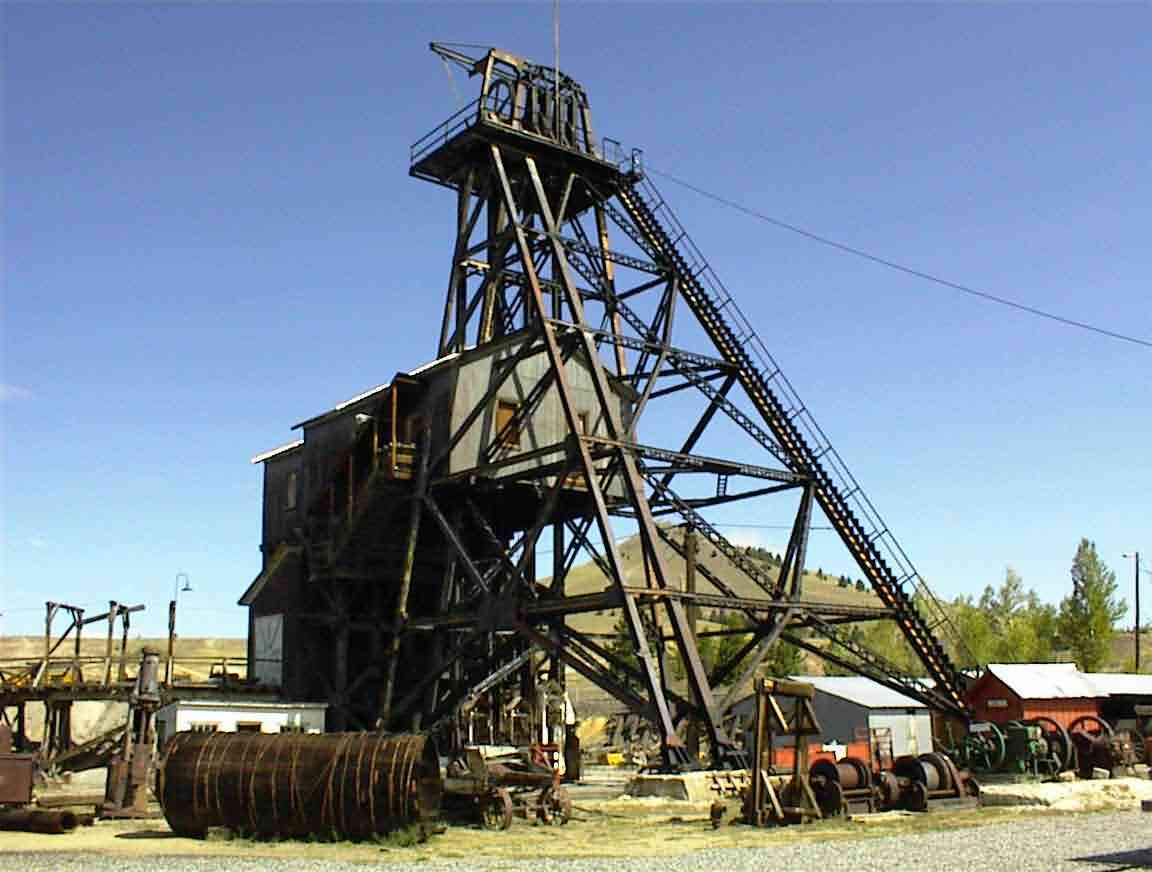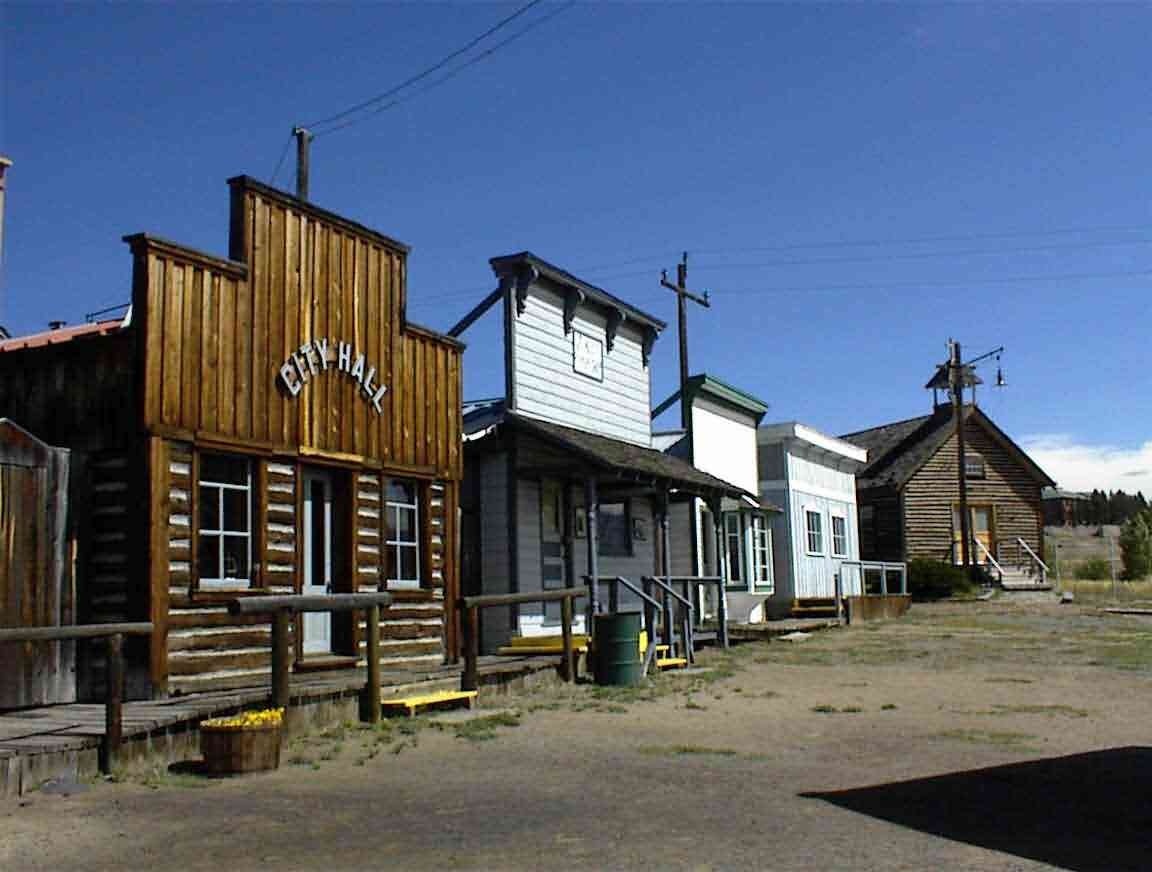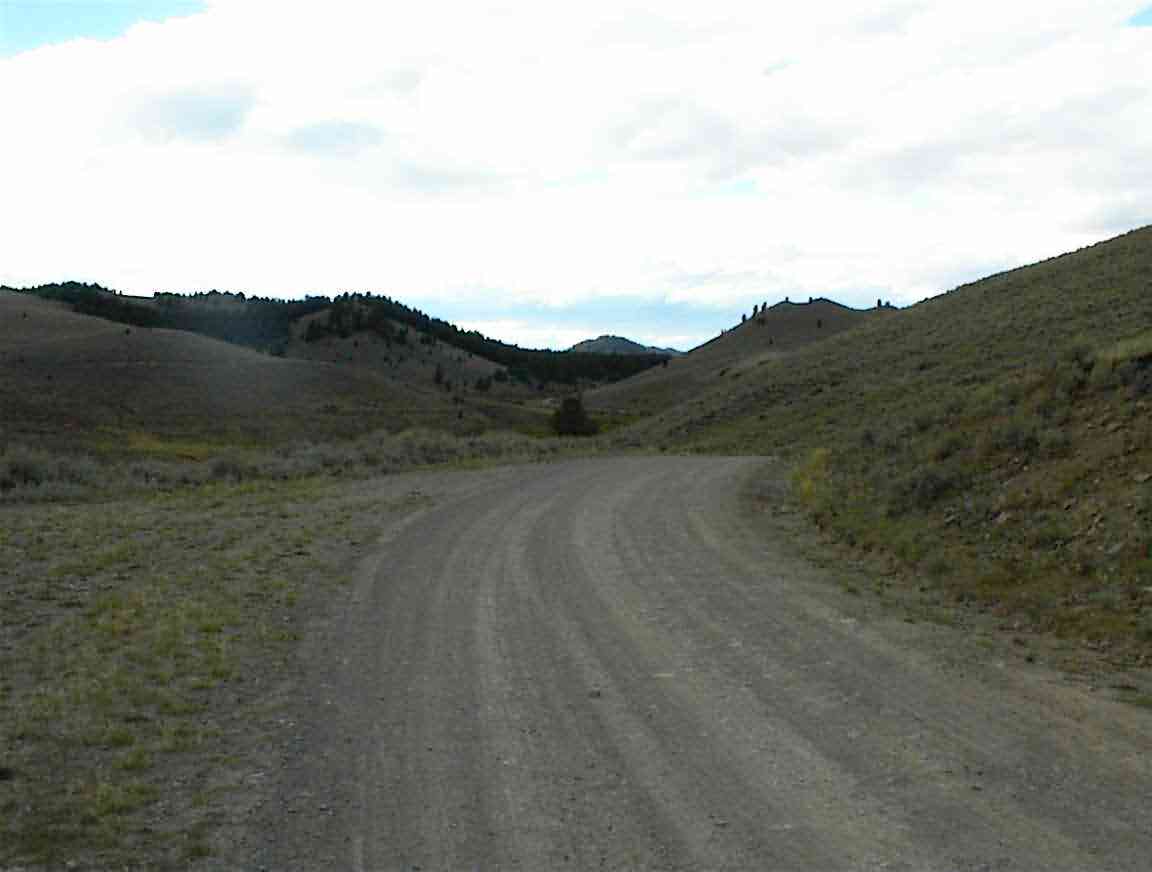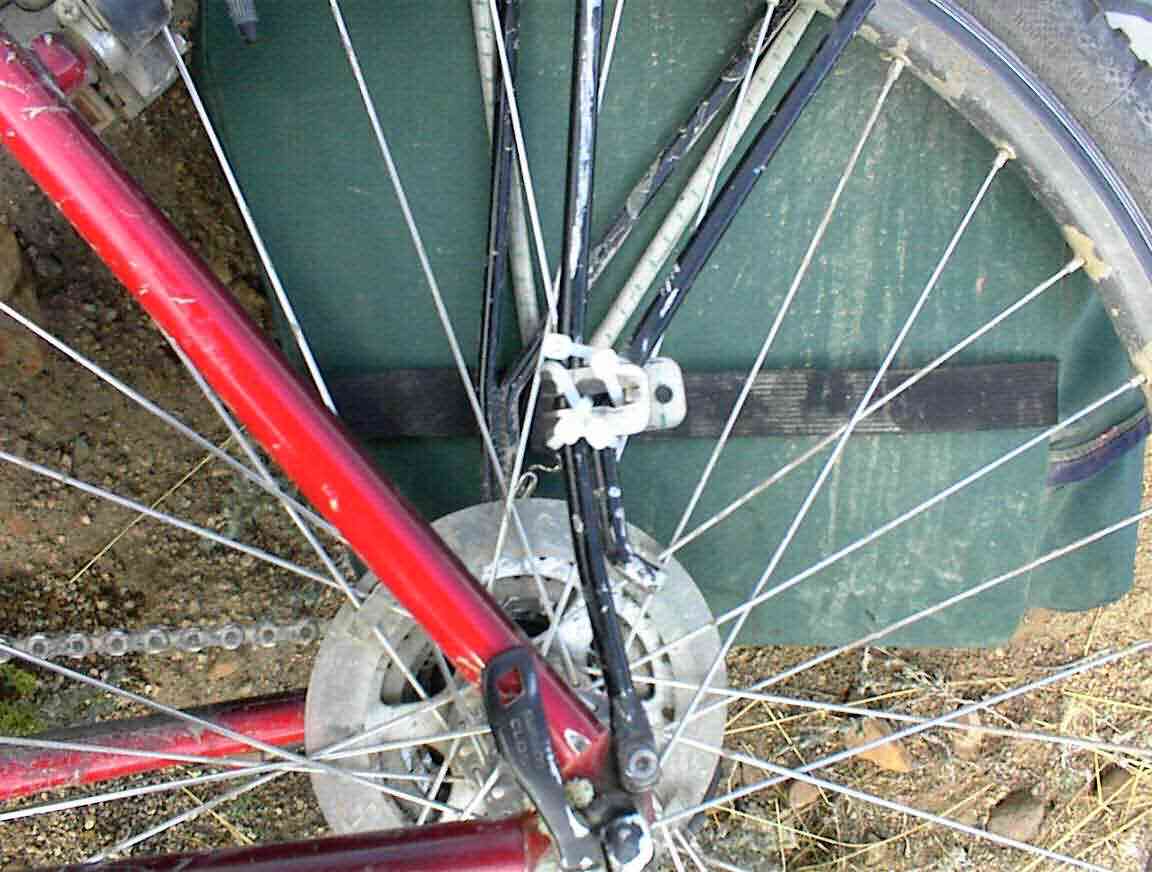Day 13: Butte to near Divide - 37 miles
After checking out we cycled across the street to the Safeway supermarket to replenish our supplies; it was to be a few days before the next market. It is always a difficult venture since in America one is spoiled for choice. There are just too many different companies offering the same product; life in NZ is much easier where the consumer has much less choice, that is unless one wants something that is unavailable (like Hellman's mayonaise).
From there it was across the street for breakfast at 'Jokers' which was adjacent to the hotel. Like many other eateries in Montana this was a combination casino and restaurant. Although I am totally opposed to casinos, we have yet to go to a restaurant where there wasn't at least two or three slot machines.
I had my usual, pancakes, while Sean indulged his carnivorous tastes with bacon, eggs and pancakes. The pancakes were excellent, although they gave me too much and I was only able to eat two of the three they provided. I also enjoyed a toasted bagel which, along with Hellman's mayonaise, are the other thing that NZ lacks. Otherwise it's a perfect place.
When I was about to pay the bill Pete came in. His wife Alyce was also doingthe Great Divide cycle and he saw our bikes parked outside the restaurant. He wanted to know if we needed a shower or to do laundry which was very kind of him. We said that we had just indulged ourselves in a motel but we really appreciated the offer. Americans are so kind and friendly. Alyce was doing the trip with a BOB trailer and finding it tough in places; we could empathise. She did the route from Park Lake to Butte in one day and we were very impressed. Pete said that she got there at 9 p.m. and was absolutely shattered. No surprise there.
From the restaurant we headed UP into Butte towards the 'World Museum of Mining'. The upper town of Butte is marketed as America's largest historic district, comprising of hundreds of historical buildings dating back to Butte's pre-eminance as a mining town. While this may upset people from Butte, we found it to be a very tired and depressing place. Many of the old buildings looked like the best thing that could be done would be to put a match to them, although they were often intersperced with restored buildings that showed their former glory. Unfortunately, these seemed to be the exception rather than the rule.
Indeed, later on we spoke with a resident who said that the number one crime in Butte is arson as people torch their homes to claim the insurance money. He also said that it is common for people to buy the neighbouring property for a song and then demolish it to give them a larger yard. One friend of his was pleased (of a sorts) when someone died in the house next door since that meant that the price was even lower and for $10,000 he doubled the size of his property.
There were a number of large buildings in downtown Butte, which was at the top of a VERY long hill. The theatre was particularly impressive with large corinthian columns. It had been restored and looked very respectable. We also passed a large bank which was now a restaurant, but by and large the commercial district also seemed to be on the way down.
Over more hills took us past the Montana Technical University, which was very pleasant, and over to the mining museum which was adjacent to the university. The university had a very large mining department, which comes as no surprise given Butte's history of mining, but today the focus is apparently on cleaning up the detritus from old mines as opposed to digging new ones so environmental engineering is the rage.
Built on the location of the 'Orphan Girl' mine, the museum was founded 35 years go to preserve Montana's mining and other historical heritages. Sean wasn't interested so he stayed outside to fix his bike but as a museumoholic I couldn't resist so in I went.
The range of exhibits they had was impressive, but unfortunately there were few narratives so one often didn't know what one was looking at. This was unfortunate as there was a large array of historical mining equipment and I would have loved to know what they were used for and how they worked. Typical engineer's response.
It was interesting to see the three-dimensional models of mine and their various shafts. Apparently litigation was popular amongst mine owners (it still is a favourite American passtime) and these were used in court to convince the judge of the validity of the competing claims. The mines went everywhere and apparently there are over 3,000 miles of shafts under Butte. I could believe it looking at some of the models.
They had kept the original pit head which is shown in the photo below. It was a huge structure with several cages for raising and lowering the miners. I recalled the time Lis and I visited a coal mine in Wales and donned overalls and a miner's lantern to descend to the depths. Once underground it was very interesting, but I couldn't fathom spending my entire working life down there. The mines used horses underground and, at least in Wales, they were required to spend 1 week above ground per year. At the end of the week they did all they could to avoid going back underground. Not at all surprising ...

While Butte had gold and silver, it was copper which brought most of the wealth. I was staggered to read that when first mined there were no smeltering facilities anywhere in the USA so the high grade ore was shipped to Utah overland, from there by rail to the east coast of the USA and then to Wales where the only smelters were. Fortunately for Butte the mine owners managed to convince some Welsh to come over and they started their own smelter.
The town ended up as a polyglot of different nationalities, Welsh, Cornish, Irish, Serbs, Croats, Chinese, and more. The Chinese had an interesting history. They tended to work the mine tailings to extract minerals that the first processing had missed. The museum noted that whereas the europeans were interested in the 'quick' find; the Chinese were prepared to work conscientiously and build up their wealth that way. There was once a large Chinatown in the city, but like many others they have moved on.
Another feature of the museum was 'Hell Roaring Gultch'. This was the name given to the area near the mine and the museum has moved in a number of historical buildings to show what life was like in the last century. As you can see from below, it looks just like an old western movie, and I half expected Clint Eastwood to step out from one of the buildings.

They had every facet of western life represented, from the grocery store through the saloon to the ice merchant. Within each building they had assembled the paraphenalia of old life, from clothes to trinkets to the merchandise the various places sold. For me the scariest was the dentist ... I think I would have put up with lots of pain before subjecting myself to the foot powered drill. But then I'm not renouned for my love of dentists.
Having completed a most enjoyable tour of the museum it was time to hit the road. Sean and I cycled through town and wound our way south. After stopping at a supermarket for Sean to get a sandwich we headed south on Highway 2. This was a slightly different route to the regular one, but it allowed us to join the recommended route later without needless backtracking.
We passed lots of car lots, shopping malls and other commercial enterprises as we headed out of town towards the mountains. There was also a strong headwind which made cycling less than pleasant. Fortunately, we turned SW and it became something of a tailwind which kind of made up for the discomfort of the cycling. Headwinds are such a drag ...
The route took us into Beaverhead-Deerlodge National forest which was a winding canyon with trees on either side. Even though it was a Sunday on a long weekend, there was not a lot of traffic and the hills on the side protected us from the winds which was a real plus. Eventually we turned onto Roosevelt Drive which would take us up into the hills. This was paved and so made for pleasant cycling, at least until the grades started.
If there is a recurring theme to cycling in Montana it is grades. In the 2 weeks of cycling we crossed 14 mountain ranges. This excluded the small hills where the climb was less than 1000'. Today was no exception and we ascended from Butte somewhere under 2000' to have our continental divide crossing #5. The route was much like the others, up and up on unsealed roads.
The skies were ominous and I was certain that we were going to get hit by rain. As the divide was at around 7400', it was quite cool without the sun shining and I was often wearing my cycling jacket to keep warm, in spite of the grade! There was a lot more traffic on this route, or it seemed so, with vehicles enveloping us in clouds of dust as they zoomed past.
We met two walkers, Ken and Mary, who were from San Francisco. They were walking the divide and left New Mexico in late April. After over 4 months of walking they expected to finish in another 2 weeks. And I thought that we were crazy. In fact while we were chatting a white pickup truck stopped and the driver said to us that we were 'all crazy' before heading off. Probably true.
Later, we were rewarded with great views down to Butte, but unfortunately because of the overcast sky the photo didn't come out. Pity as it showed just how far up we had climbed!
Futher on we met three young men in their late teens sitting by the side of the road with rifles. They were from Dillon and spending the long Labour Day weekend hunting. They said that they had only killed a grouse but had been unable to find it. I said that's good since I was morally opposed to hunting, but Sean did wish them good luck much to my consternation. Non-hunters must really be the exception up here. Indeed, I am writing this journal in a room bedecked with the heads of all sorts of animals on the walls. It just seems such a waste to destroy such beautiful creatures that God has created.
We eventually reached the Divide but it was so overcast that the photos to celebrate the event didn't come out. From there it was downhill, of a sorts, towards the interstate. I say of a sorts since we had about 8 miles of down and up terrain. We would go down a hill, only to be presented with a climb at the bottom. Or we would climb a hill, and have hardly any downhill run. Sean commented that it was unfair to climb to over 7000' and not get a decent downhill. I had to agree.
The road was also not particularly good. At one point it somehow caused the draw string on my panier cover to come loose. It then became wrapped around my rear gears. This was a hassle but I eventually managed to cut the elastic and get it unwrapped. However, it was nothing compared to what happened later.

I hit a bump too fast and heard a 'twang'. Great I thought; broken spoke. However, when I stopped my bike I found that I had broken my rear panier carrier! The vertical aluminium frame had sheared off and was flapping in the breeze.
When cycle touring there are only three potential catastrophes: (1) bent wheel; (2) broken derailleur; (3) broken pannier frames. Pretty well everything else can be overcome without too many problems. This was bad news. Parking the bike I removed the panniers to examine the damage. It was pretty bad. The shear was at the junction with the rear support frame and adjacent to a weld.
I emptied my toolkit on the ground to see what I had available. While Sean suggested tape, I knew that wouldn't last at all (he later admitted to not being very much of a handyman!). When I was younger my father called me a 'master of mickey mouse mechanics', due to my propensity to fix things with a metal coathanger (something *he* taught me), but this was going to be a real challenge.
It needed something out of steel which could be wrapped around the area and held tight. We had unfortunately disposed of our garbage otherwise a tin can would have sufficed (with some manipulations). Perhaps it was time for an early dinner ... I then spied a spare panier bracket that I had. This was a bit narrow but was definitely strong enough. Using plastic cable ties I managed to put it in place and hold it together. This worked great, and the photo below shows the final solution. My friend Peter Withers would be proud; he is the only other person I know who always has cable ties handy sinced they can help solve a multitude of problems.

It was then downhill, but at a much more subdued pace. Finally, we got a decent downgrade but I wasn't able to make much of it. After passing under the interstate Sean suggested we camp there for the night, but I wasn't keen so we cycled onto a service road adjacent to the interstate and headed onwards. We were both tired but good camping sites were not to be found. The wind was still terrible and our enthusiasm was sapping away when we found an ideal place next to the road, sheltered from the wind by an embankment.
Ignoring the 'Private Property' sign we opened the gate and after a dinner of noodles had an early night. I read my book on the Lewis and Clark expedition for a while before giving in to the exhausted sleep that is so common these days.